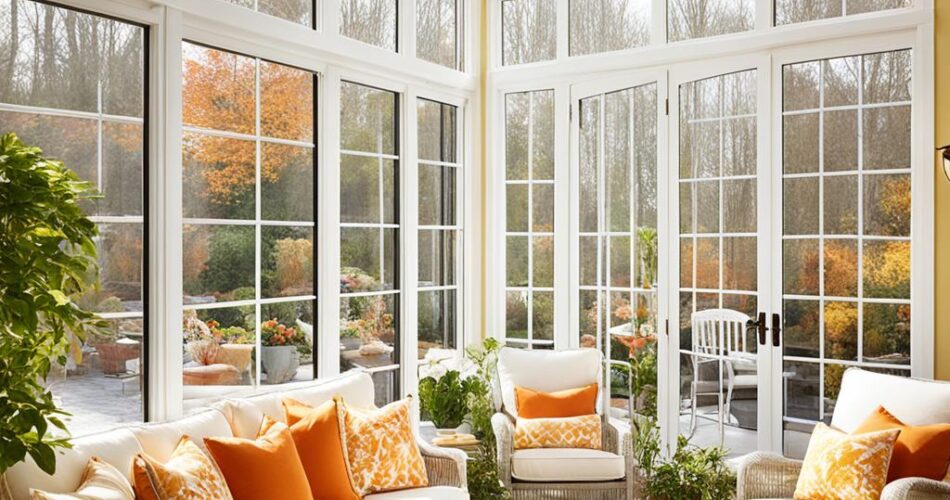Sunrooms are becoming more popular across the US. They offer a perfect mix of indoor comfort and outdoor feel. These spaces are great for relaxing, dining, or enjoying natural light.
Our guide has inspiring ideas for your perfect sunlit sanctuary. We cover styles from modern designs to cozy enclosed patios.
We’ll show you how to make the most of natural light. You’ll learn about choosing the right furniture and adding plants.
Our tips work for both new builds and existing sunrooms. You’ll find plenty of ideas to make your sunroom a beloved part of your home.
Key Takeaways
- Sunrooms bridge the gap between indoor and outdoor living
- Natural light and plant incorporation are crucial elements in sunroom design
- Versatile furniture and comfortable seating enhance sunroom functionality
- Color schemes and decorative elements can dramatically transform sunroom ambiance
- Proper insulation and lighting are essential for year-round sunroom enjoyment
- Sunroom designs can range from modern minimalist to rustic farmhouse styles
Understanding Sunrooms: Types and Functions
Sunrooms bring nature indoors, offering year-round natural light enjoyment. These versatile additions come in various types. Let’s explore different sunroom options and their unique features.
Three-season vs. Four-season Sunrooms
Three-season rooms are ideal for mild climates. They’re typically used from spring to fall. These rooms offer less insulation and climate control, making them more affordable.
Four-season rooms are built for year-round use. They feature better insulation, HVAC systems, and energy-efficient windows. These sunrooms provide comfort in all weather conditions.
| Feature | Three Season Room | Four Season Room |
|---|---|---|
| Cost Range | $15,000 – $40,000 | $25,000 – $80,000 |
| Climate Control | Fan/Space Heaters | HVAC System |
| Glass Type | Gen 1 Insulated | Comfort 365® |
| Frame Material | 4-inch Aluminum | 6-inch Vinyl-covered Aluminum |
Solarium vs. Conservatory: Key Differences
Solariums and conservatories feature glass roofs and walls. They allow maximum light entry. Solariums have a modern design, while conservatories often show a traditional style.
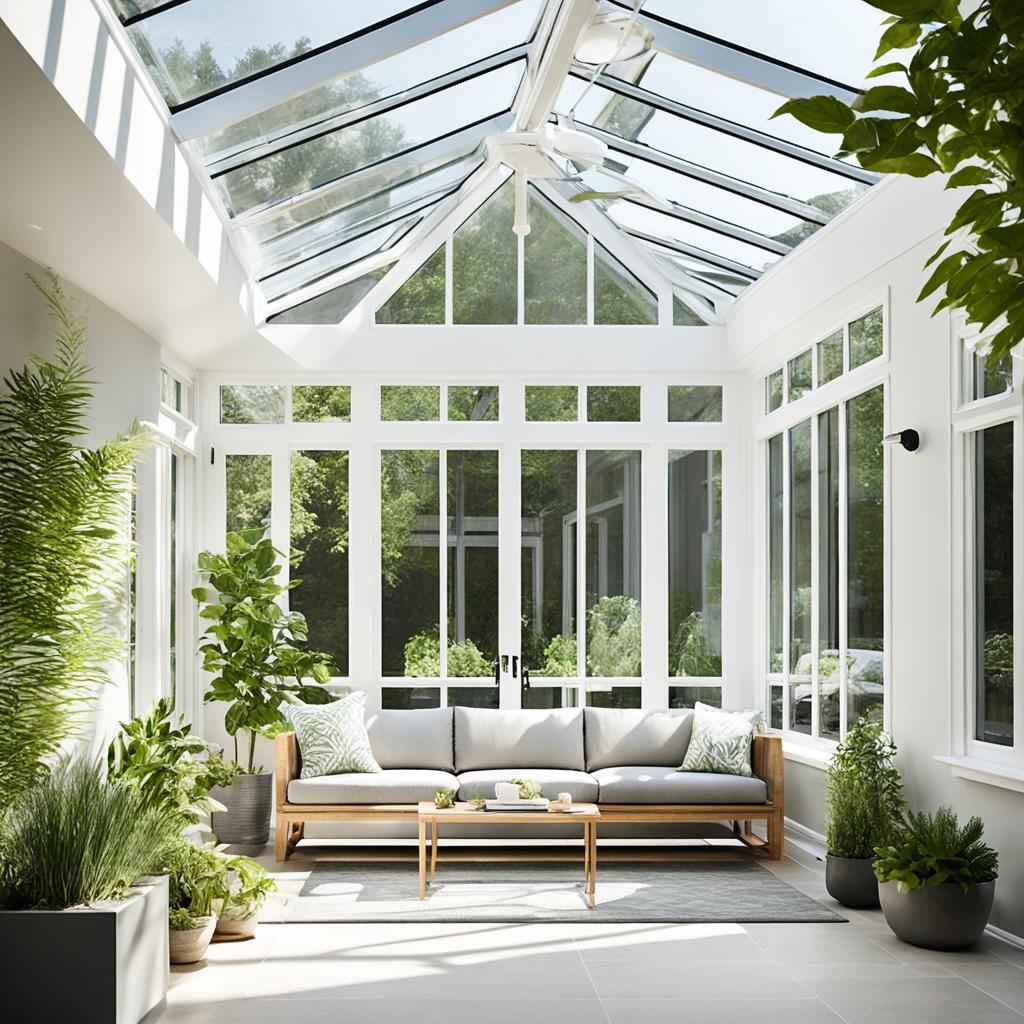
These structures create ideal environments for plants. They’re popular for indoor gardens. They offer stunning views but may experience temperature fluctuations.
Multi-purpose Sunroom Designs
Multi-purpose sunrooms maximize functionality by incorporating various living spaces. These versatile areas serve many purposes. They can be living rooms, dining areas, or home offices.
- Living rooms with comfortable seating
- Dining areas for al fresco meals
- Home offices with natural light
- Exercise rooms surrounded by nature
- Art studios with inspiring views
Consider flexible furniture and storage for multi-purpose sunrooms. Create a space that adapts to your lifestyle. Enjoy natural light and outdoor views in your versatile sunroom.
Essential Elements of Sunroom Design

A well-planned sunroom can enhance your living space and boost property value. Let’s explore the key components that make a sunroom shine.
Natural light is crucial in sunroom design. Large windows flood the space with sunshine. Skylights or clerestory windows can add extra brightness in areas with limited wall space.
The sunroom layout is vital for functionality. Consider these popular options:
- Cozy seating area with plush furniture
- Dining space for entertaining
- Home office nook with a desk and chair
- Reading corner with a comfortable window seat
Choose the right materials for durability and comfort. Opt for weather-resistant flooring like tile or sealed concrete. Add warmth with moisture-resistant rugs.
For furniture, wicker and rattan are popular choices. They withstand sunlight exposure well.
Environmental controls ensure year-round comfort. Install ceiling fans for air circulation. Consider a fireplace for chilly evenings. Privacy shades help manage heat and glare.
“A sunroom should be a sanctuary that connects you with nature while providing the comforts of home.”
Incorporate these decorative elements to elevate your sunroom design:
- Vibrant colors like turquoise, orange, or yellow for a lively atmosphere
- Indoor-outdoor textiles for durability and style
- Greenery to bring nature inside
- Whimsical accessories like vintage finds or art pieces
- Layered textures in fabrics and materials
Keep simplicity in mind for sunroom design. Create a space that feels open and airy. Focus on connecting with the outdoors.
With these elements, your sunroom will become a cherished retreat. It’ll be perfect for relaxation and enjoyment.
Sunroom Ideas for Every Style
Sunrooms offer endless possibilities for personalization. Different styles cater to various tastes, from modern designs to cozy retreats. Let’s explore some inspiring ideas for your perfect sunroom.
Modern and Minimalist Sunrooms
Modern sunrooms embrace clean lines and neutral colors. Sleek furniture with minimal ornamentation is key. Large windows and glass walls maximize natural light.
Consider adding floating shelves for a clutter-free look. Mid-century modern tulip chairs can add style. Pendant lights with geometric shapes enhance the modern feel.
- Floating shelves for a clutter-free look
- Mid-century modern tulip chairs
- Pendant lights with geometric shapes
- Monochromatic color scheme with pops of bold color

Rustic and Farmhouse-inspired Spaces
Rustic and farmhouse sunrooms exude warmth and charm. Natural materials like wood and stone create a cozy atmosphere. These elements bring the outdoors inside.
Use a weathered wooden ladder for hanging plants. An antique crib bench offers unique seating. Wood accent walls or exposed beams add rustic character.
- Weathered wooden ladder for hanging plants
- Antique crib bench for seating
- Wood accent walls or exposed beams
- Vintage crocks and salvaged windows as decor
Tropical and Bohemian Retreats
Create a tropical oasis or bohemian paradise in your sunroom. These styles use vibrant colors, lush greenery, and eclectic decor. They bring a relaxed, vacation-like feel.
A wicker swing egg chair adds a relaxed vibe. Bold, patterned wallpaper or a watercolor mural creates visual interest. Mix colorful textiles and throw pillows for comfort.
- Wicker swing egg chair for a relaxed vibe
- Bold, patterned wallpaper or a watercolor mural
- Variety of potted plants and hanging baskets
- Mix of colorful textiles and throw pillows
Classic and Traditional Sunroom Designs
Traditional sunrooms blend elegance with comfort. Focus on timeless furniture pieces and classic architectural elements. These create a sophisticated yet welcoming space.
White wicker chairs or a slipcovered wingback offer classic seating. Lantern-style chandeliers provide ambient lighting. Turkish or Oriental rugs add warmth and character.
- White wicker chairs or a slipcovered wingback
- Lantern-style chandeliers for ambient lighting
- Turkish or Oriental rugs for warmth
- French doors leading to the garden
| Sunroom Style | Percentage of Popularity | Key Design Elements |
|---|---|---|
| Modern | 15% | Clean lines, neutral colors, minimalist furniture |
| Rustic/Farmhouse | 20% | Natural materials, vintage accents, cozy textures |
| Tropical/Bohemian | 25% | Vibrant colors, eclectic decor, abundant greenery |
| Traditional | 20% | Classic furniture, elegant lighting, timeless patterns |
| Other Styles | 20% | Mix of various elements and personal preferences |
Your sunroom should reflect your personal style. Mix elements from different designs to create a unique space. Let your creativity shine in your sunroom.
Maximizing Natural Light in Your Sunroom
Sunrooms bring the outdoors inside. Maximizing natural light is key to creating a bright, inviting atmosphere. Let’s explore ways to flood your sunroom with sunshine.
Window Treatments for Sunrooms
Choose light, airy fabrics for your sunroom windows. Sheer curtains or cellular shades are excellent choices. These options let you control light levels without blocking the view.
- Sheer curtains: Diffuse light softly
- Cellular shades: Offer light control and insulation
- Roman shades: Provide elegance and adjustability
- Plantation shutters: Allow precise light management
Reflective Surfaces and Mirrors
Use reflective surfaces to bounce light around your sunroom. Mirrors, glossy finishes, and metallic accents can increase the room’s brightness. Place a large mirror opposite the main windows to double the light.
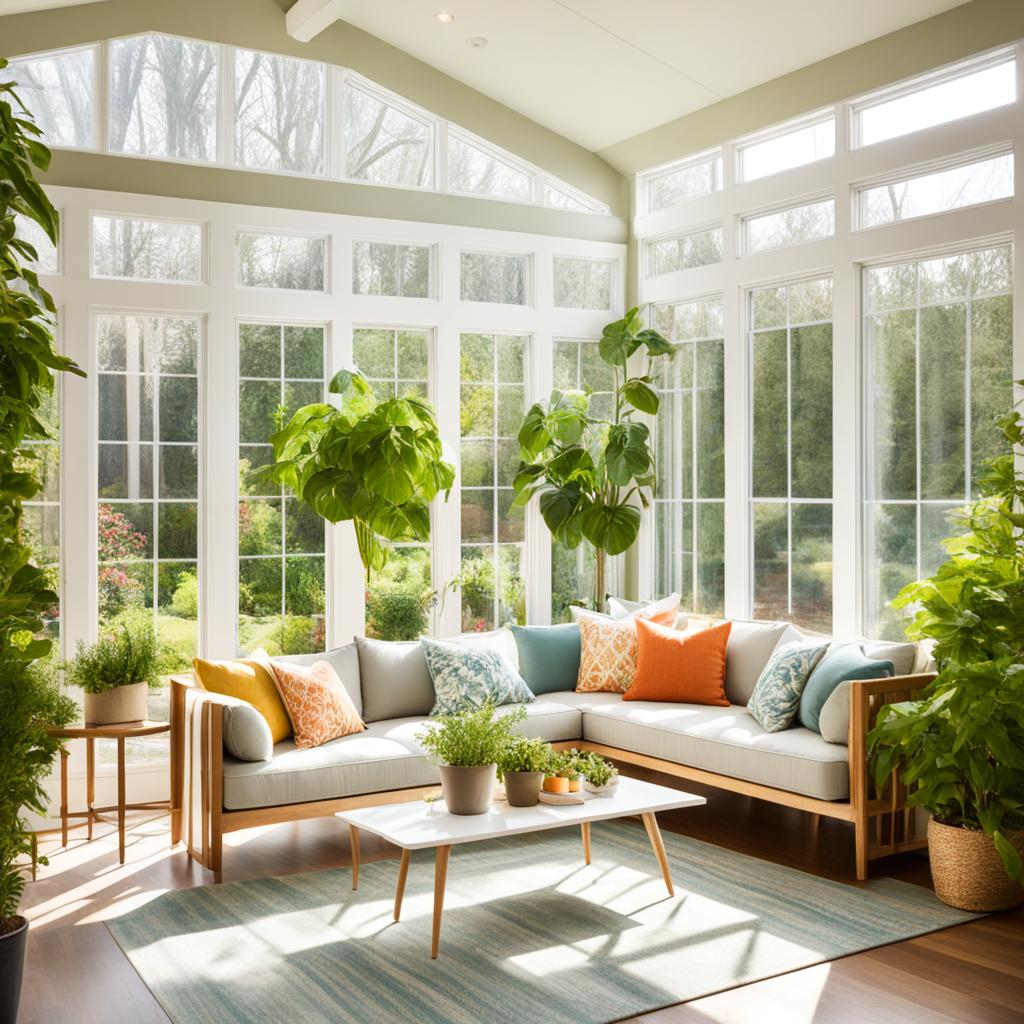
Skylights and Clerestory Windows
Add skylights or clerestory windows for more natural light. These features increase light, improve ventilation, and create an open feel. They can transform your sunroom’s ambiance.
| Feature | Benefits | Considerations |
|---|---|---|
| Skylights | Flood room with light, enhance design | Proper placement for energy efficiency |
| Clerestory Windows | Improve airflow, add architectural interest | Installation height for optimal light |
Energy-efficient skylights provide insulation and UV protection. They help maintain a pleasant indoor temperature while minimizing energy costs.
“Skylights can enhance the overall design and functionality of a sunroom by allowing sunlight to flood the living space and creating an ambiance that draws the eye.”
Use these strategies to create a bright, welcoming sunroom. Balance light, comfort, and style to craft your perfect sunlit sanctuary.
Sunroom Furniture and Layout Tips
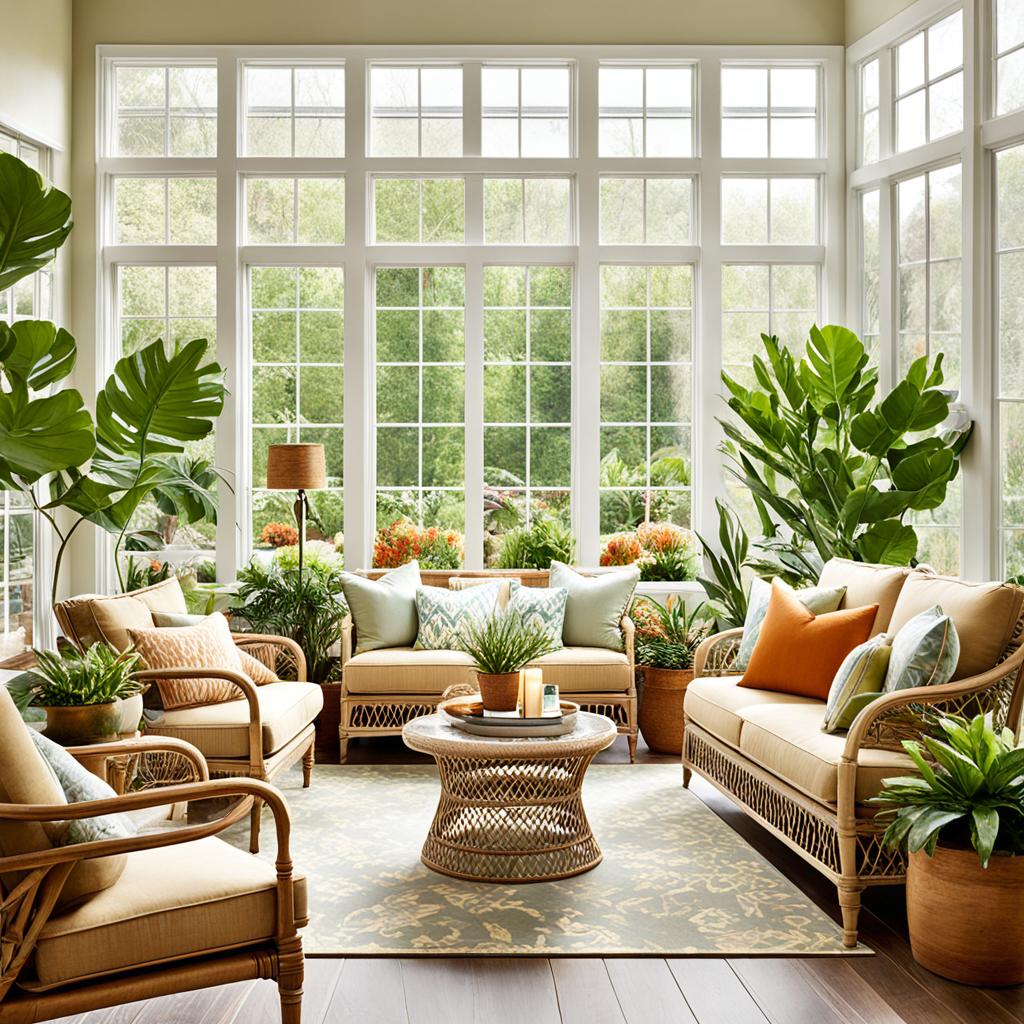
Choosing the right furniture is crucial for a perfect sunroom layout. Your sunroom furniture should be comfy and match the room’s purpose. Select pieces that fit your vision, whether it’s for reading or entertaining.
Place furniture to maximize views and natural light. Arrange seating to face windows or sliding glass doors. This allows you to enjoy the outdoors from inside.
For larger sunrooms, create separate zones for different activities:
- Relaxation area with a sectional and plush pillows
- Dining space with a table and chairs
- Reading corner with a comfortable armchair
Weather-resistant materials are essential for sunroom furniture. Choose fabrics and finishes that can withstand sunlight and temperature changes. This is vital in areas with extreme weather conditions.
“A well-designed sunroom blends interior comfort with outdoor elements, creating a unique space that connects you with nature year-round.”
For smaller sunrooms, consider built-in corner benches. These offer extra seating and storage without taking up much floor space. Use baskets under furniture for practical storage solutions.
| Sunroom Type | Furniture Recommendations | Layout Tips |
|---|---|---|
| 3-Season | Wicker or rattan sets, outdoor rugs | Create a conversation area facing the view |
| 4-Season | Upholstered sectionals, indoor-outdoor fabrics | Divide space into living and dining zones |
| Conservatory | Bistro sets, plant stands | Leave open space for plant displays |
Match your sunroom design with the rest of your home. Coordinate finishes and fixtures for a smooth transition between spaces. This creates a unified look throughout your house.
With careful selection and arrangement, you’ll create an inviting retreat. Your sunroom will be perfect for relaxation, entertainment, or simply enjoying the sun.
Incorporating Nature: Plants and Greenery in Sunrooms
Plants bring nature indoors and create a vibrant sunroom space. They add beauty, improve air quality, and create a peaceful atmosphere. Let’s explore how to pick and care for indoor plants in your sunny oasis.
Best Plants for Sunroom Environments
Choosing the right sunroom plants is key for a thriving indoor garden. Here are some top choices:
- Ficus trees
- Snake plants
- Bird of paradise
- Rubber plants
- Fiddle leaf figs
These plants thrive in bright, indirect light. They can handle temperature changes common in sunrooms.
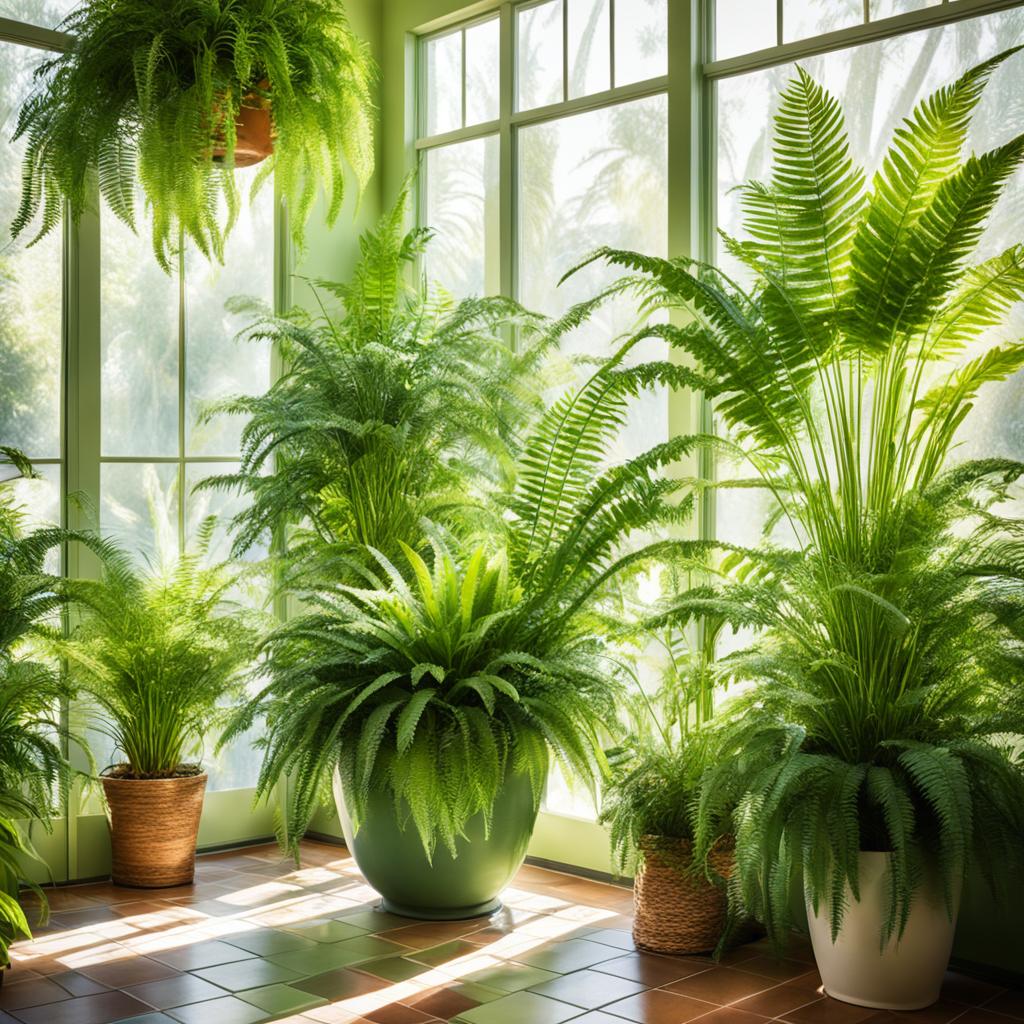
Creative Plant Display Ideas
Boost your sunroom’s look with unique plant display ideas:
- Hanging macrame planters
- Tiered plant stands
- Window box herbs
- Vertical garden walls
- Floating shelves with trailing plants
Combine these displays to create a lush, layered look. This approach makes the most of your sunroom’s vertical space.
Maintenance Tips for Sunroom Plants
Good plant care keeps your indoor oasis healthy all year. Here are some key maintenance tasks:
| Task | Frequency | Tips |
|---|---|---|
| Watering | 1-2 times per week | Check soil moisture before watering |
| Fertilizing | Monthly (growing season) | Use balanced, water-soluble fertilizer |
| Pruning | As needed | Remove dead or yellowing leaves |
| Dusting | Bi-weekly | Wipe leaves with a damp cloth |
| Rotating | Weekly | Ensure even light exposure |
Follow these guidelines to create a thriving plant haven. Each plant has unique needs, so adjust care routines as needed.
“A sunroom without plants is like a sky without stars. Let your indoor garden shine!”
Color Schemes and Decorating Ideas for Sunrooms
The right sunroom colors can turn your space into a vibrant oasis. A good color scheme sets the mood and blends indoor comfort with outdoor beauty.
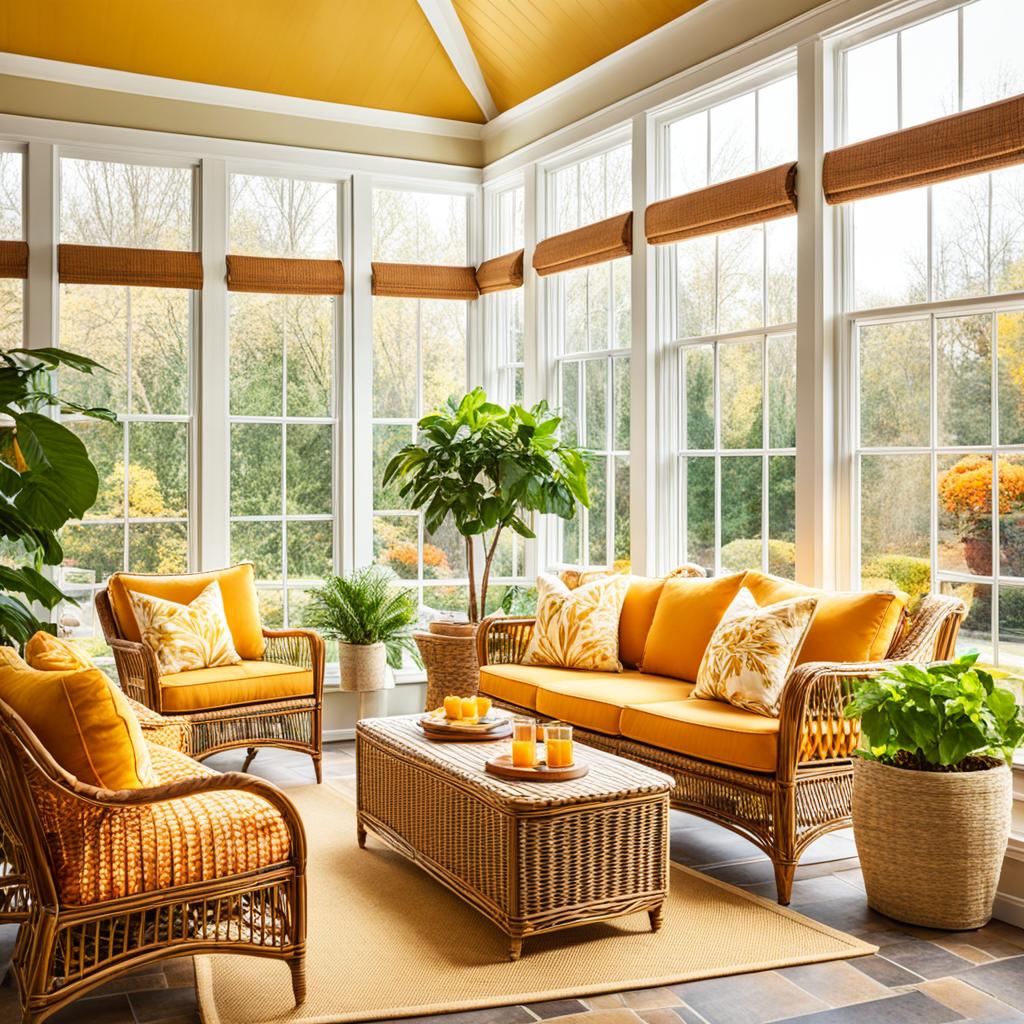
White is popular for sunroom paint, making spaces feel big and bright. Sherwin-Williams’ Alabaster, Marshmallow, and Creamy are top picks. Yellow brings cheer, while blue hues offer a calm feel like outdoor patios.
When picking sunroom colors, think about these options:
- Nature-inspired palettes to blend with outdoor views
- Pastel shades for a serene backdrop
- Warm browns to create a cozy atmosphere
- Neutrals like tan, beige, and gray for sophistication
Test colors in different light, as it changes throughout the day. High-quality paint ensures easy cleaning and fade resistance. This keeps your sunroom vibrant over time.
Try these decorating tips to enhance your sunroom:
- Add mustard-colored curtains for an uplifting touch
- Incorporate patterned rugs and woven rocking chairs for rustic flair
- Use throw pillows and accent chairs to introduce pops of color
- Include folding stools for versatile seating and accent tables
- Create a gardening hub with a small table, tools, and planters
For a striking focal point, try a hexagonal coffee table with an inlay pattern. Mix textures like latticework over lime green paint to bring the outdoors in.
“A sunroom is a canvas waiting to be painted with the colors of nature and personal style.”
Combine these color schemes and decorating ideas thoughtfully. You’ll create a sunroom that’s more than just a room extension. It’ll be a cozy retreat celebrating natural light and comfort.
Flooring Options for Sunrooms
Picking the right sunroom flooring is key for a cozy, lasting space. Let’s look at tough materials, cool designs, and textile choices for your sunny spot.
Weather-resistant Flooring Materials
Sunroom floors need to be tough and handle temp changes. Here are some great picks:
- Tile: Absorbs solar energy, making it energy-efficient and easy to maintain
- Luxury Vinyl Plank (LVP): Resists stains, mildew, and scratches while mimicking wood or stone
- Engineered Hardwood: Less susceptible to moisture damage than solid wood
- Concrete: Saves on heating costs by absorbing heat during cooler months
- Linoleum: Durable, eco-friendly, and budget-friendly option
Decorative Floor Painting Techniques
Painted floors can make your sunroom pop. Try these ideas:
- Stenciled patterns for a custom look
- Faux tile designs using paint and tape
- Geometric shapes for a modern feel
- Nature-inspired motifs to bring the outdoors in
Area Rugs and Textiles for Sunroom Floors
Rugs can define spaces and add warmth to your sunroom. Keep these tips in mind:
- Choose weather-resistant materials like polypropylene or treated natural fibers
- Use rugs to create distinct zones in multi-purpose sunrooms
- Layer smaller rugs for added texture and interest
- Consider indoor/outdoor rugs for easy maintenance
| Flooring Type | Durability | Maintenance | Cost |
|---|---|---|---|
| Tile | High | Low | Moderate |
| LVP | High | Low | Low to Moderate |
| Hardwood | Moderate | High | High |
| Concrete | Very High | Low | Low to Moderate |
Choose your sunroom flooring with care. You’ll create a lovely, useful space that stands up to the weather and matches your home’s style.
Lighting Solutions for Day and Night Use
Sunroom lighting creates a versatile space for day and night use. Natural light floods your sunroom during the day. Artificial lighting ensures its usability after sunset.
To calculate the right light amount, multiply your room’s square footage by 40. A 15 x 10 foot sunroom needs about 6,000 lumens of light.
Here are some lighting types for your sunroom:
- Ambient lighting: Provides overall illumination
- Task lighting: Focuses light on specific areas
- Accent lighting: Highlights architectural features or artwork
For ambient lighting, choose overhead fixtures like ceiling fans with lights or chandeliers. Table lamps or adjustable floor lamps work well for task lighting. Picture lights or portable spotlights can serve as accent lighting.
Sunrooms have many reflective surfaces. Overhead lamps directing light downward help control brightness levels. Pendant-style lamps offer flexibility in focusing light where needed.
| Lighting Type | Best Options for Sunrooms | Benefits |
|---|---|---|
| Ambient | Ceiling fans with lights, chandeliers | Even illumination, improved air circulation |
| Task | Table lamps, adjustable floor lamps | Focused light for reading or work areas |
| Accent | Picture lights, LED tape lights | Highlights features, creates ambiance |
Install dimmer switches to adjust light levels for a cozy atmosphere. This creates perfect mood lighting for relaxation or entertaining. Your sunroom becomes more versatile in the evening.
“The right lighting can transform your sunroom from a daytime retreat to an enchanting evening oasis.”
Your sunroom lighting should complement natural light during the day. It should also provide ample illumination at night. The right mix of lighting solutions makes your sunroom shine around the clock.
Conclusion: Creating Your Perfect Sunlit Sanctuary
Designing your dream sunroom combines style and functionality. It offers endless possibilities to reflect your unique taste. From cozy reading nooks to lively entertainment areas, balance natural light, comfort, and practicality.
Consider eco-friendly materials like bamboo or reclaimed wood for your sunroom. Place furniture strategically to maximize natural light and create warmth. Use space-saving options such as multipurpose tables and foldable chairs for style and comfort.
A well-designed sunroom enhances indoor-outdoor living and increases home value. It provides a year-round escape for relaxation, meditation, or yoga. Personalize your space with colors, textures, and decor.
Your sunroom can become a versatile retreat that blends seamlessly with nature. It will be your favorite spot in any season.
